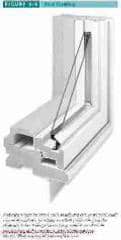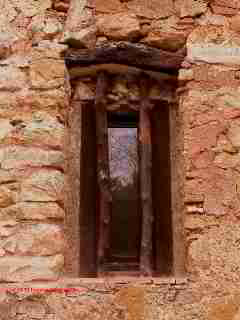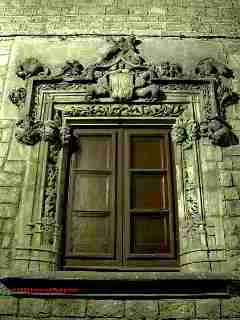 Guide to Window Materials & Construction Methods
Guide to Window Materials & Construction Methods
- POST a QUESTION or COMMENT about the properties, materials & methods of construction of windows
What are the different materials used to construct windows & what are their different performance properties?
Here we explain the properties of current window types and what they are made-of, including wood windows, clad wood windows, vinyl cladding on wood windows, fiberglass cladding on wood windows, solid vinyl windows, fiberglass windows, and aluminum windows.
InspectAPedia tolerates no conflicts of interest. We have no relationship with advertisers, products, or services discussed at this website.
- Daniel Friedman, Publisher/Editor/Author - See WHO ARE WE?
Guide to Window Materials and Construction
 In this article series we discuss the selection and installation of windows and doors, following best construction and design practices for building lighting and ventilation, with attention to the impact on building heating and cooling costs, indoor air quality, and comfort of occupants.
In this article series we discuss the selection and installation of windows and doors, following best construction and design practices for building lighting and ventilation, with attention to the impact on building heating and cooling costs, indoor air quality, and comfort of occupants.
We review the proper installation details for windows and doors, and we compare the durability of different window and door materials and types. This article includes excerpts or adaptations from Best Practices Guide to Residential Construction (Steve Bliss, J Wiley & Sons) , by Steven Bliss, courtesy of Wiley & Sons.
Article Contents
As described in Best Practices Guide to Residential Construction (Steve Bliss, J Wiley & Sons) Chapter 3, BEST PRACTICES GUIDE: WINDOWS & DOORS:
For centuries, even before glass was used for glazing, windows were framed with wood set into building walls. Our photo (left) shows an antique wood-framed window in Rugat, Spain (DF).
Earliest wood framed windows were left open (such as this example from Xotolar, Mexico). Later in areas of more hostile climate windows were glazed with animal skins, then parchment, and finally, glass.
For many years, the material choices for "modern" or new residential windows were limited to wood, clad wood, and aluminum. Wood and clad wood remain the leading materials, accounting for almost 50% of the new and replacement window market. Wood use has been declining, however, with the rapid growth of solid vinyl windows.
Solid vinyl windows made inroads into the replacement window market in the mid-1980s; but they were not widely accepted in new homes until the 1990s, when their use skyrocketed. Solid vinyl windows now account for an estimated 30% of the new-home market and 60% of the replacement market.
Aluminum windows account for about 15% of window sales, with the remaining share of the market spread among fiberglass windows and a variety of hybrids and composites that have entered the fray, making window selection today anything but simple.
Wood and Clad-Wood Windows
 Wood is the traditional material of choice for residential
windows. It can be milled into highly detailed designs,
such as true divided lites, and easily fashioned into just
about any custom configuration.
Wood is the traditional material of choice for residential
windows. It can be milled into highly detailed designs,
such as true divided lites, and easily fashioned into just
about any custom configuration.
Photo at left, masonry window details, Barcelona, Spain demonstrate stone masonry window trim details.
In addition to its aesthetic appeal, wood has excellent insulation value, and if well maintained can last indefinitely. Our photo (left) of a wood-built casement window set into this stone wall in Barcelona, Spain, shows a window that is more than 100 years old.
On the downside, wood must be stained or painted and well-maintained or, over time, it will be vulnerable to peeling paint and decay. Windows with wood exposed directly to the weather, such as open casements, are particularly vulnerable.
Although wood is dimensionally stable with temperature changes, it does swell and shrink with changes in relative humidity, causing tight-fitting windows to stick in humid summer weather.
When selecting a wood window, look for materials that are factory-treated with a water-repellant preservative, which will help prevent decay and also improve paint retention and dimensional stability.
The vast majority of
wood windows made today have a vinyl- or aluminumclad
exterior. A clad exterior is the most practical choice,
providing a maintenance-free exterior with the look of a
wood window on the interior. The only downside is a limited
color choice.
Construction Details for Wood Windows
 Some very high-end wood windows are
manufactured from rot-resistant species, such as mahogany,
but most use clear pine for the sash and visible
portions of the frame.
Some very high-end wood windows are
manufactured from rot-resistant species, such as mahogany,
but most use clear pine for the sash and visible
portions of the frame.
The hidden portions of most wood windows use some combination of solid wood, finger jointed lumber, and various types of engineered lumber, including laminated-strand lumber (similar to oriented strand board, or OSB).
Watch out: Leaks into wood window or door components can cause severe rot even on newer products, as our photo (left) illustrates.
And where finger-jointed wood is used for window or other wood parts exposed to the weather, if the wood is not kept painted and sealed, we find that finger joints may swell, separate, and invite rot or insect damage - DF.
Composite windows are beginning to be used as well, such as Fibrex, a proprietary wood-vinyl composite used in the subsills of some of Andersen’s replacement windows and patio doors.
In general, wood windows are sufficiently strong and rigid for most residential applications. However, it is always best to use windows approved by one of the three agencies that certify windows and doors (see Window Certification).
In coastal areas or other areas prone to high winds or hurricanes, look for products with a suitable pressure rating from the American Architectural Manufacturers Association (AAMA) or the Window and Door Manufacturer’s Association (WDMA).
Vinyl Cladding on Wood Windows
While vinyl cladding is only offered by a few manufacturers, one of them is Andersen Windows, by far the largest supplier of residential windows in the United States. Andersen’s clad windows’ strong record of durability, reliability, and moderate cost has helped make vinyl-clad windows one the most popular options today.
Good quality vinyl-clad windows have a heavy-gauge covering, and heat-welded corners to provide a durable seal against water entry. Vinyl cladding is also more energy efficient than aluminum and is preferred by some in coastal environments subject to salt spray.
Watch out: on some older versions of vinyl clad windows that leave wood exposed (typically at the ends of sills projecting outdoors) or where vinyl cladding over wood has been damaged, broken, or cracked, we often find rot as well.

On the downside, vinyl comes in only a few colors, typically white and beige, and cannot be painted.
Some manufacturers, such as Andersen, now offer a limited number of dark tones as well, using newer technologies that resist the fading and heat problems characteristic of dark colored vinyl.
Vinyl is also vulnerable to cracking in cold weather if struck by an errant baseball or hammer.
While all manufacturers cover the exterior frame and exterior face of the sash, some also protect the top of the sash, which is important in casement windows.
Andersen wraps the entire sash inside and out, providing excellent protection (see Figure 3-3 at left).
But for those seeking the look of wood on the interior of the sash, consider windows with exterior-only cladding, such as those from Weathershield and MW Manufacturing.
See vinyl window details at VINYL WINDOWS.
Aluminum Cladding on Wood Windows
A number of manufacturers offer aluminum cladding, using either relatively thin roll formed aluminum or heavier-gauge extruded aluminum. The advantage of extruded aluminum is that it adds strength and rigidity to the window and resists denting better than thinner stock.
Also, aluminum can be formed to crisper profiles than vinyl, creating a less bulky appearance. Other advantages of aluminum include a wider choice of colors and the ability to be painted if desired. One downside to aluminum cladding is a slight reduction in energy-efficiency compared to vinyl-clad windows. On average, a vinyl-clad unit has an R-value about 10% higher than for a comparable aluminum-clad window.
See aluminum window details at ALUMINUM WINDOWS.
Properties of Fiberglass Clad Windows
A few manufacturers, including Marvin and Milgard, offer wood windows clad on the exterior with a tough fiberglass composite manufactured in a process called pultrusion (see FIBERGLASS WINDOWS).
Pultruded fiberglass is an ideal cladding material due to its durability, energy efficiency, and very low rate of thermal expansion. Unaffected by heat, cold, and moisture, manufacturers claim that pultruded fiberglass will never crack, peel, or warp. Fiberglass-clad windows come prepainted with a factory finish and can be repainted on site if desired.
Where to buy window and door products
As noted in Best Practices Guide to Residential Construction (Steve Bliss, J Wiley & Sons) Chapter 3, BEST PRACTICES GUIDE: WINDOWS & DOORS:
- Andersen Windows and Doors www.andersenwindows.com Vinyl-clad windows and patio doors, including storm resistant models
- Atrium Companies Inc. www.atriumcompanies.com Vinyl and aluminum windows and patio doors
- Certainteed Corp. www.certainteed.com Vinyl windows and patio doors
- Crestline Windows and Doors www.crestlinewindows.com Wood, vinyl, and aluminum-clad windows and patio doors
- Eagle Windows and Doors www.eaglewindow.com Extruded-aluminum-clad windows and sliders with LVL frames and steel entry doors
- Fibertec Windows and Door Manufacturing www.fibertec.com Pultruded fiberglass windows and doors
- Hurd Windows and Doors www.hurd.com Wood, vinyl, and aluminum clad windows and patio doors
- Jeld-Wen Windows and Doors www.jeld-wen.com Wood, vinyl, aluminum-clad, and aluminum windows and patio doors
- Kolbe Windows and Doors www.kolbe-kolbe.com Wood, vinyl, and aluminum-clad windows and patio doors
- Marvin Window and Doors www.marvin.com Wood and extruded-aluminum-clad windows and patio doors, including true divided lites and storm-resistant models
- Milgard Windows and Doors www.milgard.com Wood, aluminum, vinyl, and fiberglass-clad windows and patio doors
- MW Windows www.mwwindows.com Wood, vinyl, and vinyl-clad windows and patio doors
- Peachtree Doors and Windows www.peach99.com Vinyl-clad and aluminum-clad windows with optional hardwood interior; aluminum-clad, steel, and fiberglass patio doors with optional hardwood interior
- Pella Windows and Doors www.pella.com Wood and aluminum-clad windows and patio doors with optional between-the-glass shades and blinds, including storm-resistant models
- Thermotech Windows Ltd. www.thermotechwindows.com Complete line of fiberglass pultruded windows
- Weather Shield Windows and Doors www.weathershield.com Wood, vinyl, vinyl-clad, and aluminum-clad windows and patio doors, including historic replacement windows and storm-resistant models
- WindsorWindows and Doors www.windsorwindows.com Wood and vinyl windows and patio doors, including a line of wood windows with a cellular-PVC exterior
Skylights
- Andersen Windows and Doors www.andersenwindows.com Skylights and roof windows with exterior sash clad with glass-fiber-reinforced material
- Milgard Windows and Doors www.milgard.com Skylights with aluminum frames (thermal break optional) with vinyl subframes on operable models; optional motorized controls with rain sensor
- Pella Windows and Doors www.pella.com Wood interior, aluminum exterior, optional motorized controls, and manual or motorized fabric-pleated shades
- Roto Frank of America www.roofwindows.com Wood interior, aluminum exterior, optional motorized controls, and manual or motorized fabric-pleated shades; Sweet16 model fits 16 in. o.c. framing
- Velux America Inc. www.velux.com Skylights and roof windows with wood interior and aluminum-clad exterior. Options include insect screens, blinds, motorized controls and shades with rain sensor, electrochromatic glass, and flashing kits for metal and tile roofs and mulled units
- Skylight Light Tube Manufacturers & Sources
- SolaTube www.solatube.com Light tubes from 10 to 21 in. in diameter; options include electrical lighting, daylight dimmer, and integral bath fan
- Sun-Tek Skylights www.sun-tek.com Light tubes from 10 to 21 in. in diameter; options include electrical lighting and multitube Spyder skylight
- Velux America Inc. www.velux.com Sun Tunnel light tubes from 14 to 22 in. in diameter with flexible or rigid tubes
-- Adapted and paraphrased, edited, and supplemented, with permission from Best Practices Guide to Residential Construction (Steve Bliss, J Wiley & Sons) .
...
Continue reading at WINDOW TYPES - PHOTO GUIDE or select a topic from the closely-related articles below, or see the complete ARTICLE INDEX.
Or see
WINDOWS & DOORS - home
Suggested citation for this web page
WINDOW MATERIALS & CONSTRUCTION at InspectApedia.com - online encyclopedia of building & environmental inspection, testing, diagnosis, repair, & problem prevention advice.
Or see this
INDEX to RELATED ARTICLES: ARTICLE INDEX to DOORS & WINDOWS
Or use the SEARCH BOX found below to Ask a Question or Search InspectApedia
Ask a Question or Search InspectApedia
Questions & answers or comments about the properties, materials & methods of construction of windows.
Try the search box just below, or if you prefer, post a question or comment in the Comments box below and we will respond promptly.
Search the InspectApedia website
Note: appearance of your Comment below may be delayed: if your comment contains an image, photograph, web link, or text that looks to the software as if it might be a web link, your posting will appear after it has been approved by a moderator. Apologies for the delay.
Only one image can be added per comment but you can post as many comments, and therefore images, as you like.
You will not receive a notification when a response to your question has been posted.
Please bookmark this page to make it easy for you to check back for our response.
IF above you see "Comment Form is loading comments..." then COMMENT BOX - countable.ca / bawkbox.com IS NOT WORKING.
In any case you are welcome to send an email directly to us at InspectApedia.com at editor@inspectApedia.com
We'll reply to you directly. Please help us help you by noting, in your email, the URL of the InspectApedia page where you wanted to comment.
Citations & References
In addition to any citations in the article above, a full list is available on request.
- Basic Housing Inspection, US DHEW, S 352.75 U48, p.144, out of print, but is available in most state libraries; New York State version, ca 1955, source of our window parts and window repair sketches.
- Best Practices Guide to Residential Construction, by Steven Bliss. John Wiley & Sons, 2006. ISBN-10: 0471648361, ISBN-13: 978-0471648369, Hardcover: 320 pages, available from Amazon.com and also Wiley.com. See our book review of this publication.
- Our recommended books about building & mechanical systems design, inspection, problem diagnosis, and repair, and about indoor environment and IAQ testing, diagnosis, and cleanup are at the InspectAPedia Bookstore. Also see our Book Reviews - InspectAPedia.
- Decks and Porches, the JLC Guide to, Best Practices for Outdoor Spaces, Steve Bliss (Editor), The Journal of Light Construction, Williston VT, 2010 ISBN 10: 1-928580-42-4, ISBN 13: 978-1-928580-42-3, available from Amazon.com
- The Journal of Light Construction has generously given reprint permission to InspectAPedia.com for adaptations, quotations, or reproductions used at this website. All rights and contents of the JLC material are ©Journal of Light Construction and may not be reproduced in any form.
- In addition to citations & references found in this article, see the research citations given at the end of the related articles found at our suggested
CONTINUE READING or RECOMMENDED ARTICLES.
- Carson, Dunlop & Associates Ltd., 120 Carlton Street Suite 407, Toronto ON M5A 4K2. Tel: (416) 964-9415 1-800-268-7070 Email: info@carsondunlop.com. Alan Carson is a past president of ASHI, the American Society of Home Inspectors.
Thanks to Alan Carson and Bob Dunlop, for permission for InspectAPedia to use text excerpts from The HOME REFERENCE BOOK - the Encyclopedia of Homes and to use illustrations from The ILLUSTRATED HOME .
Carson Dunlop Associates provides extensive home inspection education and report writing material. In gratitude we provide links to tsome Carson Dunlop Associates products and services.

